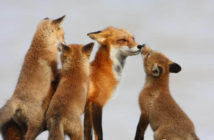Spring and summer are busy times of the year. There are new plants to be put in the ground or in pots, bird feeders and birdhouses to be hung, vegetables and flowers to be babied, and lawns to be mowed. And aren’t there always assorted other things that come up? But, with the first brisk mornings of fall, it may seem like all that should be over for the year. If you want to make your yard friendlier for wildlife through the coming months of winter, however, there’s more to be done. Here’s what to do to prepare your yard for wildlife in winter.
Nesting boxes
Clean and disinfect all nesting boxes. Careful, though—position yourself so you won’t be inhaling any of a box’s contents as you empty it. Better yet, use a face mask or towel over your nose and mouth; there could be tiny parasites in there.
Despite that possibility, don’t apply insecticides or other pesticides to the boxes. Instead, disinfect them using one part bleach to 9 parts water. Rinse and let them dry completely. After that, store them away until early spring or put them back in your yard so birds will have a clean shelter through the winter.
Feeders, birdbaths
Bird feeders and birdbaths must be periodically cleaned year-round, so fall is a good time to do it again while the weather’s still beautiful. (You can move the job to your garage if the weather becomes inclement, but don’t take them indoors in case there are parasites.) Fortunately, in winter, they won’t need cleaning as often, about every four to six weeks. Place them where they’ll stay through the winter, whether in storage or outdoors.
Does winter bring freezing temperatures to your area? If so, is your birdbath heated? Birdbath heaters use very little electricity because they warm the water only enough to keep it liquid. Water is as essential to wildlife in winter as in summer. Sometimes more so—whether everything’s dry or everything’s frozen, it’s all the same for a dehydrated animal, and it can be the difference between life and death. You can find heated birdbaths locally at seed stores or online or buy a separate heater.
Clean plant debris out of ponds and water features. Rotting vegetable matter will deplete oxygen in the water, putting frogs and other helpless hibernating animals at risk.
Flora
Leave plant stalks, seedheads, and tall grasses standing through the winter. They’ll add some visual interest to your winter landscape, but, more importantly, wildlife will use them for food and shelter.
Fallen leaves are a great mulch. Leave them where they lay or mulch them with your mower to scatter them 2–3 inches (5–8 cm) deep in your garden. Mulch helps conserve moisture in the soil and adds organic matter. Or, add the leaves to your compost pile.
Do you have a brush pile? If not, start one with the next collection of branches and twigs you rake up. Hide it behind shrubs or elsewhere in your yard where it won’t be a visual bother to you. As you add to it over time, it’ll provide a place for rabbits to hide and for reptiles, amphibians, and insects to hibernate. (It will be used in spring and summer by ground-nesting birds and other wildlife.)
Evaluate
Once you’ve prepared your yard, it’s an excellent time to evaluate your landscape and make plans for the following spring and summer. Consider this:
- Several, if not most, of the plants, shrubs, and trees in your yard should produce food for wildlife in one form or another throughout the year. Do they?
- Do at least some plant varieties provide places for hiding and nesting?
- Evergreens are valuable for year-round shelter. Consider adding one or more.
- Can you convert an area of turfgrass into a butterfly or hummingbird garden?
- Do you have a suitable spot for a small frog pond or water feature? It will be used by numerous wildlife.
More reading:
How to design a backyard wildlife habitat
Food sources for wildlife
How to clean birdhouses and feeders
If you see this, it must be fall






